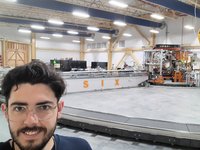Interview with Prof. Young- June Kim:
Could you describe the primary focus of your research project? What specific objectives or questions are you aiming to address through your research?
One of the goals of quantum condensed matter physics is to find a new state of matter and describe its physical properties. We learned in school that phases of matter can change by temperature change. For example, raising the temperature, which is equivalent to increasing the thermal agitation of atoms, will turn ice into water. In the same manner, even at zero temperature, we can crank up quantum “agitation” and “melt” a solid via purely quantum mechanical effects. One example is called quantum spin liquid, which is expected when the quantum effect becomes too strong to sustain magnetic order in a magnet. Although quantum spin liquids are predicted by theory, whether this phase can be found in real materials is a contentious issue. The goal of our research group, along with many other groups in the world, is to discover a new material that exhibits a quantum spin liquid phase. To do so, we also have to study various types of quantum materials and gain a deep understanding of the magnetic properties of these materials.
What methodologies or approaches are you employing in your research? Are there any innovative or unique aspects to your research methods?
Our group’s research has two distinct aspects. In one, we spend a lot of time in our lab trying to synthesize new quantum materials. This requires painstaking trial and error working with lots of chemicals, so, yes, we had to learn lots of chemistry as well. Once we have good single-crystal samples, we use neutron and X-ray scattering to investigate their properties. Because neutrons and X-ray photons have wavelengths similar to atomic length scales, they are excellent “agents” to go deep into the materials and extract information about the material. A particularly innovative tool we helped develop in recent years is called resonant inelastic X-ray scattering, or RIXS, which allows us to study elementary excitations in extremely tiny samples. This type of experimental tool is particularly important for studying quantum spin liquids. Because a hallmark of quantum spin liquid is the presence of fractional (quasi)particles, measuring the quasiparticle’s properties like mass, charge, and spin using scattering techniques is crucial. To do these types of experiments, graduate students in our group usually travel to large international experimental facilities, such as synchrotron light sources. This can be quite a stressful experience because you have to work around the clock during the beam time given to you. But at the same time traveling around the world is also a lot of fun.
How do you envision your research impacting the broader field or society? Are there potential real-world applications for your findings?
Quantum spin liquids, and particularly the fractional particles found in such phases, are considered an essential ingredient of the next generation of quantum computing technology, called topological quantum computing. In addition, there are many technologically important materials that we study to gain a deeper understanding of the underlying physics. Many of these materials could be important for clean energy, such as superconductors for energy transmission and thermoelectric materials for energy harvesting.
What challenges have you encountered during your research, and how have you worked to overcome them? Are there specific strategies or solutions you’ve found particularly effective?
Because quantum materials tend to be extremely sensitive to even a small amount of impurities, you can be misled if your sample has many defects. A good example is our work on alpha-RuCl3, which many believe is the best candidate for quantum spin liquid. Many papers published in the early days, including our own work, reported confusing results due to variations in sample quality. To overcome this, we decided to improve sample quality. It took a lot of effort. My graduate student, Subin, spent almost two years perfecting the synthesis condition through much trial and error. In experimental research, persistence often prevails. These new improved samples gave us a clearer picture of what is happening in this material. We, along with our collaborators, are still working hard to understand the basic physics underlying this material.
What are your plans for the future of your research? Are there specific goals you hope to achieve in the next few years?
In addition to our investigation of alpha-RuCl3, we are also working on synthesizing other materials showing similar structural and magnetic properties as this material. This is one way to find another candidate for quantum spin liquid, although we are continuously on the lookout for new types of materials. What is interesting about materials like alpha-RuCl3 is that they can be easily cleaved using scotch tape, just like graphene, and it is easy to make this material into a paper-thin two-dimensional material. We are interested in creating two-dimensional quantum materials and studying their magnetic and electronic properties.
What advice would you give to other researchers in the department, especially those in related fields? Are there lessons learned from your research journey that you’d like to share?
What I found frustrating as a condensed matter physicist is that it is very difficult to predict the impact of your research. Some of my most influential work was done very hastily without too much effort, while there were many projects in which the opposite was true. We spent an enormous amount of time and energy on this project, but it resulted in a paper that attracted very little attention. The lesson I learned is not to put all eggs in one basket when running your research program. A balanced research program with some “easy” projects, along with a few ambitious projects, has been my approach, and it has worked well.


